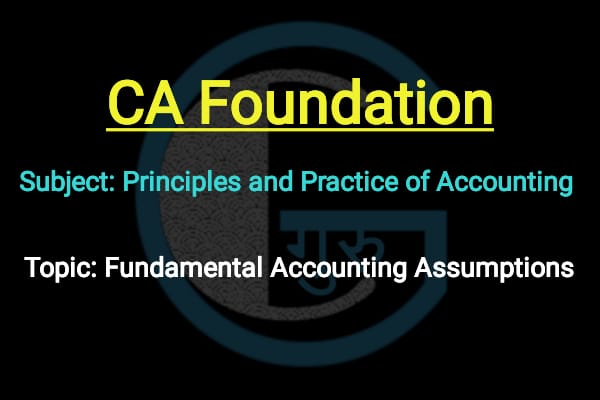There are three fundamental accounting assumptions:
- Going Concern
- Consistency
- Accrual
1. Going Concern:
The financial statements are normally prepared on the assumption that an enterprise is a going concern and will continue in operation for the foreseeable future. Hence, it is assumed that the enterprise has neither the intention nor the need to liquidate or curtail materially the scale of its operations; if such an intention or need exists, the financial statements may have to be prepared on a different basis and, if so, the basis used is disclosed. The valuation of assets of a business entity is dependent on this assumption.
Suppose Mr. A purchased a machine for his business paying Rs. 3,00,000 out of Rs. 5,00,000 invested by him. He also paid transportation expenses and installation charges amounting to Rs. 50,000. If he is still willing to continue the business, his financial position will be as follows:
Balance Sheet
| Liability | Rs. | Assets | Rs. |
| Capital | 5,00,000 | Machinery Cash | 3,50,000 1,50,000 |
| 5,00,000 | 5,00,000 |
Now if he decides to back out and desires to sell the machine, it may fetch more than or less than Rs. 3,50,000. So his financial position should be different. If going concern concept is taken, increase/ decrease in the value of assets in the short-run is ignored. The concept indicates that assets are kept for generating benefit in future, not for immediate sale; current change in the asset value is not realisable and so it should not be counted.
2. Consistancy:
In order to achieve comparability of the financial statements of an enterprise through time, the accounting policies are followed consistently from one period to another; a change in an accounting policy is made only in certain exceptional circumstances.
The concept of consistency is applied particularly when alternative methods of accounting are equally acceptable. For example a company may adopt any of several methods of depreciation such as written-down-value method, straight-line method, etc. Likewise there are many methods for valuation of inventories. But following the principle of consistency it is advisable that the company should follow consistently over years the same method of depreciation or the same method of valuation of Inventories which is chosen. However in some cases though there is no inconsistency, they may seem to be inconsistent apparently. In case of valuation of Inventories if the company applies the principle ‘at cost or market price whichever is lower’ and if this principle accordingly results in the valuation of Inventories in one year at cost price and the market price in the other year, there is no inconsistency here. It is only an application of the principle.
But the concept of consistency does not imply non-flexibility as not to allow the introduction of improved method of accounting.
An enterprise should change its accounting policy in any of the following circumstances only:
- To bring the books of accounts in accordance with the issued Accounting Standards.
- To comply with the provision of law.
- When under changed circumstances it is felt that new method will reflect more true and fair picture in the financial statement.
3. Accrual:
Under accrual concept, the effects of transactions and other events are recognised on mercantile basis i.e., when they occur (and not as cash or a cash equivalent is received or paid) and they are recorded in the accounting records and reported in the financial statements of the periods to which they relate. Financial statements prepared on the accrual basis inform users not only of past events involving the payment and receipt of cash but also of obligations to pay cash in the future and of resources that represent cash to be received in the future.
To understand accrual assumption knowledge of revenues and expenses is required. Revenue is the gross inflow of cash, receivables and other consideration arising in the course of the ordinary activities of an enterprise from sale of goods, from rendering services and from the use by others of enterprise’s resources yielding interest, royalties and dividends.
Example-1: Mr. A started a cloth merchandising. He invested Rs. 1,00,000, bought merchandise worth Rs. 1,00,000. He sold such merchandise for Rs. 1,20,000. Customers paid him Rs. 90,000 cash and assure him to pay Rs. 30,000 shortly. His revenue is Rs. 1,20,000. It arose in the ordinary course of cloth business; Mr. A received Rs. 90,000 in cash and Rs. 30,000 by way of receivables.
Example-2: An electricity supply undertaking supplies electricity spending Rs. 15,00,000 for fuel and wages and collects electricity bill in one month Rs. 18,00,000 by way of electricity charges. This is also revenue which arose from rendering services.
Example-3: Mr. A invested Rs. 1,00,000 in a business. He purchased a machine by paying Rs. 1,00,000. He hired it out for Rs. 15,000 annually to Mr. B. Rs. 15,000 is the revenue of Mr. A; it arose from the use by others of the enterprise’s resources.
Expense is a cost relating to the operations of an accounting period or to the revenue earned during the period or the benefits of which do not extend beyond that period.
Accrual means recognition of revenue and costs as they are earned or incurred and not as money is received or paid. The accrual concept relates to measurement of income, identifying assets and liabilities.
Accrual Concept provides the foundation on which the structure of present day accounting has been developed.
Note: If nothing has been written about the fundamental accounting assumption in the financial statements then it is assumed that they have already been followed in their preparation of financial statements. However, if any of the above mentioned fundamental accounting assumption is not followed then this fact should be specifically disclosed.
(Also read: Assessment MCQs with Answers for CA Course)
(Also read: Requirement of mentioning UDIN while signing Audit Reports and all Certification)
(Also read: How to order Study Material at your doorsteps by Centralized Distribution System (CDS) of ICAI)

